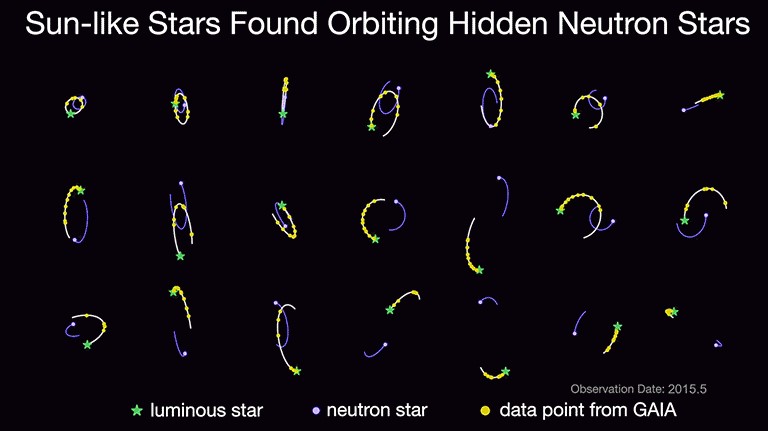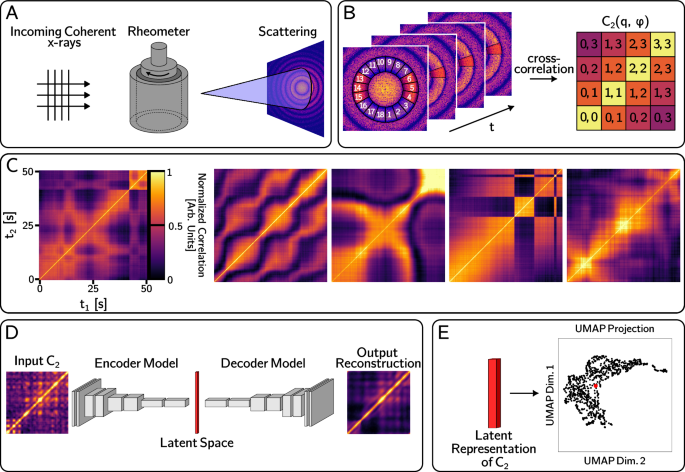2024-07-16 カリフォルニア工科大学(Caltech)

Astronomers have discovered 21 stars like our Sun in orbit around neutron stars—heavy, compact remains of massive stars that previously exploded. The hidden neutron stars were discovered through their gravitational effects alone. Though the neutron stars are heavier than Sun-like stars, the two objects mutually orbit one another around a common center of mass. As the neutron stars orbit around, they tug on the Sun-like stars, causing them to wobble. The European Space Agency’s Gaia mission detected this wobble by observing the orbits of the Sun-like stars (yellow dots) over a period of three years. The Sun-like stars are green in this animation, and the neutron stars (and their orbits) are purple.Credit: Caltech/Kareem El-Badry
<関連情報>
- https://www.caltech.edu/about/news/sun-like-stars-found-orbiting-hidden-companions
- https://astro.theoj.org/article/121261-a-population-of-neutron-star-candidates-in-wide-orbits-from-gaia-astrometry
ガイアの天体測定から得られた、広い軌道にある中性子星候補の集団 A population of neutron star candidates in wide orbits from Gaia astrometry
Kareem El-Badry,Hans-Walter Rix,David W. Latham,Sahar Shahaf,Tsevi Mazeh,Allyson Bieryla,Lars A. Buchhave,René Andrae,Natsuko Yamaguchi,Howard Isaacson,Andrew W. Howard,Alessandro Savino,Ilya V. Ilyin
The Open Journal for Astrophysics Published:July 15, 2024
DOI:https://doi.org/10.33232/001c.121261
Abstract
We report discovery and spectroscopic follow-up of 21 astrometric binaries containing solar-type stars and dark companions with masses near 1.4 <?XML:NAMESPACE PREFIX = “[default] http://www.w3.org/1998/Math/MathML” NS = “http://www.w3.org/1998/Math/MathML” />⊙. The simplest interpretation is that the companions are dormant neutron stars (NSs), though ultramassive white dwarfs (WDs) and tight WD+WD binaries cannot be fully excluded. We selected targets from Gaia DR3 astrometric binary solutions in which the luminous star is on the main sequence and the dynamically-implied mass of the unseen companion is (a) more than 1.25⊙ and (b) too high to be any non-degenerate star or close binary. We obtained multi-epoch radial velocities (RVs) over a period of 670 days, spanning a majority of the orbits’ dynamic range in RV. The RVs broadly validate the astrometric solutions and significantly tighten constraints on companion masses. Several systems have companion masses that are unambiguously above the Chandrasekhar limit, while the rest have masses between 1.25 and 1.4 ⊙. The orbits are significantly more eccentric at fixed period than those of typical WD + MS binaries, perhaps due to natal kicks. Metal-poor stars are overrepresented in the sample: 3 out of 21 objects (14%) have [Fe/H]∼−1.5 and are on halo orbits, compared to ∼0.5% of the parent Gaia binary sample. The metal-poor stars are all strongly enhanced in lithium. The formation history of these objects is puzzling: it is unclear both how the binaries escaped a merger or dramatic orbital shrinkage when the NS progenitors were red supergiants, and how they remained bound when the NSs formed. Gaia has now discovered 3 black holes (BHs) in astrometric binaries with masses above 9 ⊙, and 21 NSs with masses near 1.4⊙. The lack of intermediate-mass objects in this sample is striking, supporting the existence of a BH/NS mass bimodality over 4 orders of magnitude in orbital period.




